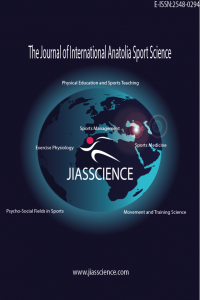THE EFFECTS OF MAXIMAL STRENGTH TRAINING ON SOME HEMATOLOGICAL AND BIOCHEMICAL PARAMETERS IN ELITE WRESTLERS
THE EFFECTS OF MAXIMAL STRENGTH TRAINING ON SOME HEMATOLOGICAL AND BIOCHEMICAL PARAMETERS IN ELITE WRESTLERS
___
- Büyükyazı, G., & Turgay, F. (2000). Sürekli ve yaygın interval koşu egzersizlerinin bazı hematolojik parametreler üzerine akut ve kronik etkileri. ve tek. Yüksekokulu VI. Spor Araştırmaları Kongresi Bildiri, Ankara, 182.
- Cengiz, Ş. Ş., & Çinar, V. (2014). The Effect of 8-Week Core Exercises on Some Hematological Parameters in Sedentary Females. Turkish Journal of Scientific Research. Vol, 1(1), 1-5.
- Çakmakcı, E. (2009). Erkek taekwondocularda kamp döneminin bazı hematolojik parametreler üzerine etkileri. Niğde Üniversitesi Beden Eğitimi ve Spor Bilimleri Dergisi Cilt 3, Sayı 1.
- Çelik, A., Varol, R., Onat, T., Dağdelen, Y., & Tugay, F. (2007). Akut egzersizin futbolcularda antioksidan sistem parametrelerine etkisi. Spormetre Beden Eğitimi ve Spor Bilimleri Dergisi, 4, 167-172.
- Çevik, C., Günay, M., Tamer, K., Sezen, M., & Onay, M. (1996). Farklı aerobik nitelikli antrenmanların serum enzimler, serum elektrolitler, üre, kreatin, total protein, fosfor ve ürik asit üzerindeki etkileri ve ilişki düzeylerinin belirlenmesi. Gazi Üniversitesi Beden Eğitimi ve Spor Bilimleri Dergisi, 1(2), 37-46.
- Demiriz, M., Erdemir, İ., & Kayhan, R. F. (2015). Farklı dinlenme aralıklarında yapılan anaerobik interval antrenmanın, aerobik kapasite, anaerobik eşik ve kan parametreleri üzerine etkileri. International Journal of Sport, Exercise & Training Sciences, 1(1), 1-8.
- Halson, S. L., Lancaster, G. I., Jeukendrup, A. E., & Gleeson, M. (2003). Immunological responses to overreaching in cyclists. Medicine and Science in Sports and Exercise, 35(5), 854-861.
- Hazar, S., & Koç, H. (2003). Türk güreş milli takımı seviyesindeki güreşçilerin kalp yapı ve fonksiyonlarının elektrokardiografi yöntemiyle incelenmesi. Gazi Beden Eğitimi ve Spor Bilimleri Dergisi, 3.
- Kara, E., Özal, M., & Yavuz, H. U. (2010). Elit güreşçi ve basketbolcuların kan ve solunum parametrelerinin karşılaştırılması. Selçuk Üniversitesi Beden Eğitimi ve Spor Bilim Dergisi, 12(1), 36-41.
- Kayhan, R. F. (2014). Farklı kuvvet antrenmanlarının kreatin kinaz enzim aktivitesi ve kan parametrelerine etkisi. Balıkesir Üniversitesi sağlık Bilimleri Enstitüsü Beden Eğitimi ve Spor Anabilim Dalı Yüksek Lisans Tezi.
- Koç, H., Tamer, K., & Çoksevim, B. (2007). Devamlı ve aralı (interval) koşu programlarının plazma üre ve kreatin düzeyleri üzerine etkisi. Sağlık Bilimleri Dergisi, 16(1), 17-22.
- Lindemann, R. (1978). Low hematocrıts durıng basıc traınıng-athletes anemıa. New England Journal of Medicine, 299(21), 1191-1192.
- Mashiko, T., Umeda, T., Nakaji, S., & Sugawara, K. (2004). Effects of exercise on the physical condition of college rugby players during summer training camp. British journal of sports medicine, 38(2), 186-190.
- Özdengül, F. (1998). Akut submaksimal egzersizin immun sisteme etkileri. Doktora Tezi Selçuk Üniversitesi. Sağlık Bilimleri Enstitüsü.
- Öztürk, Ç., Çumralıgil, B., & Çakmakçı, O. (2012). Sporcularda ve sedanter bireylerde akut egzersiz öncesi gliserol takviyesinin laktat ve maxvo2 üzerine etkileri. Beden Egitimi ve Spor Bilimleri Dergisi, 6(1).
- Rietjens, G.J., Kuipers, H., Hartgens, F., & Keizer, H.A. (2002). Red Blood Cell Profile of Elite Olympic Distance Triathletes. A thre–year follow–up. International journal of sports medicine, 23(06), 391-396.
- Vincent, H. K., & Vincent, K. R. (1997). The effect of training status on the serum creatine kinase response, soreness and muscle function following resistance exercise. International journal of sports medicine, 28(06), 431-437.
- Başlangıç: 2016
- Yayıncı: Alparslan İNCE
THE INVESTIGATION OF THE LEVEL OF SATISFACTION FOR THE DIFFERENT CATEGORIES OF THE SPORTS CENTRE
Ratko PAVLOVİC, Wilson Mariz De OLIVEIRA
KADIN BASKETBOLCULARIN SPOR YAŞINA GÖRE İMGELEME PUANLARININ KARŞILAŞTIRILMASI
Bade YAMAK, Mehmet Çebi, Murat Eliöz, Hamza Küçük, Levent CEYLAN
